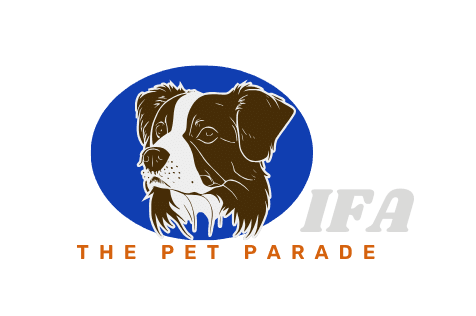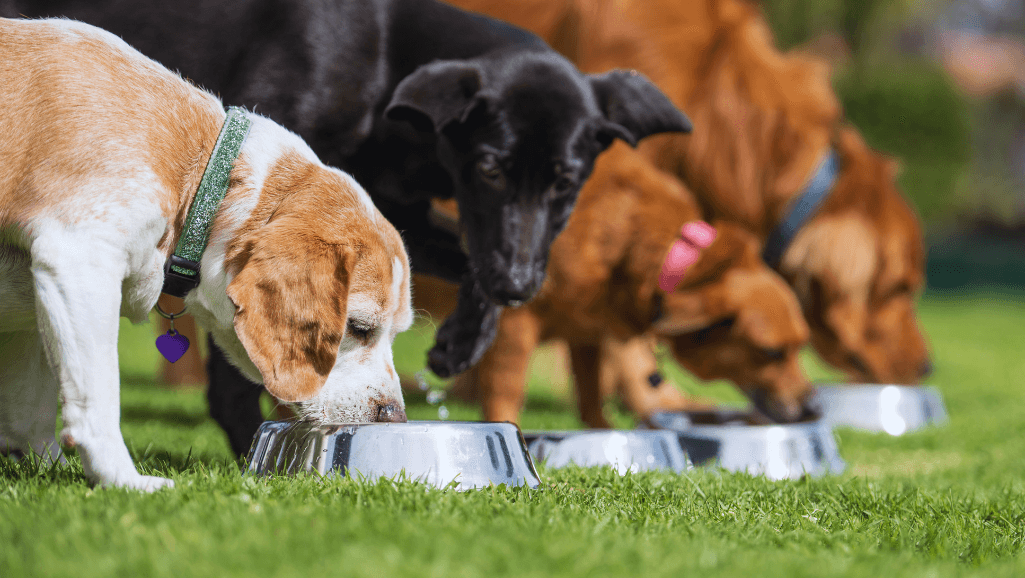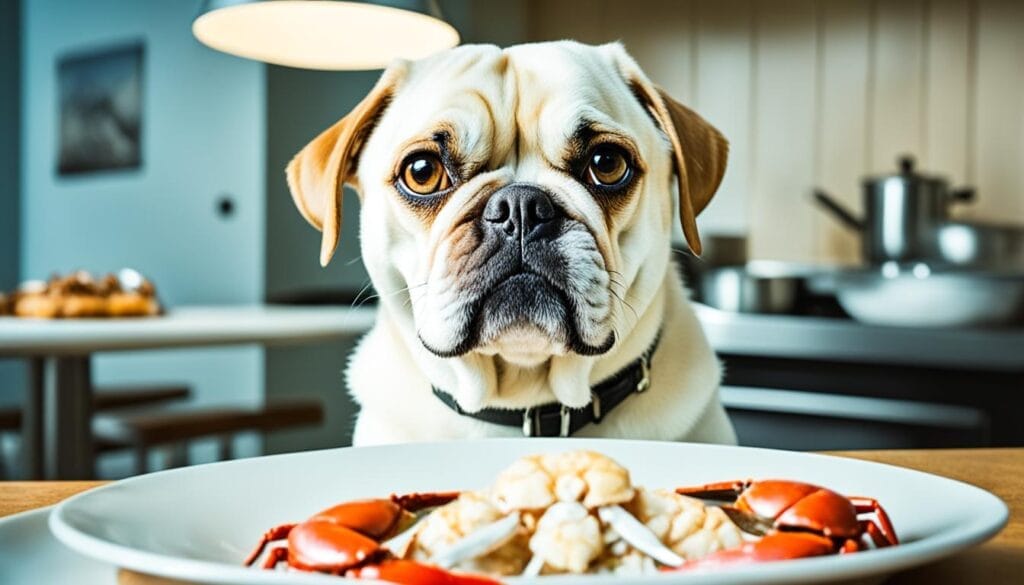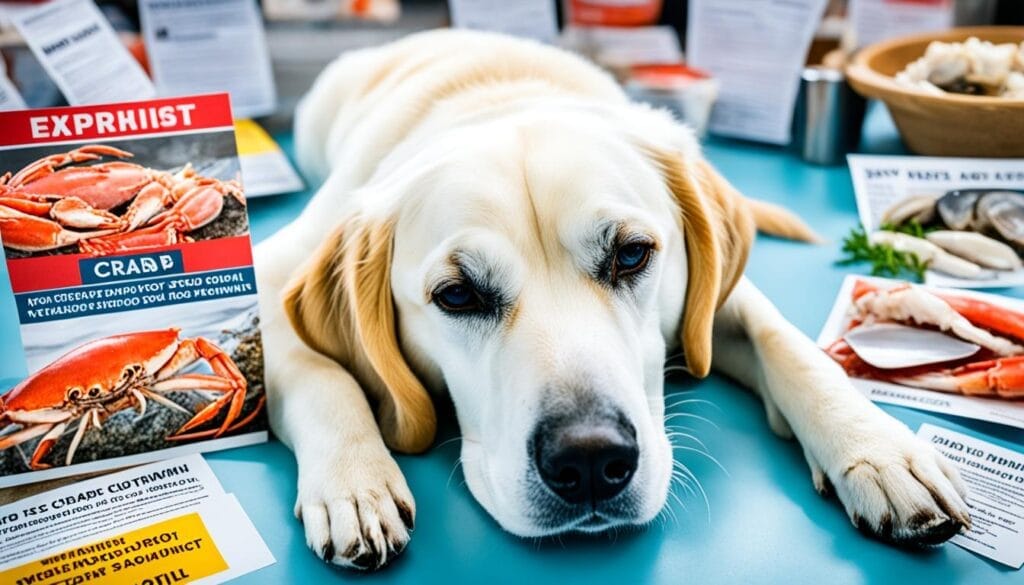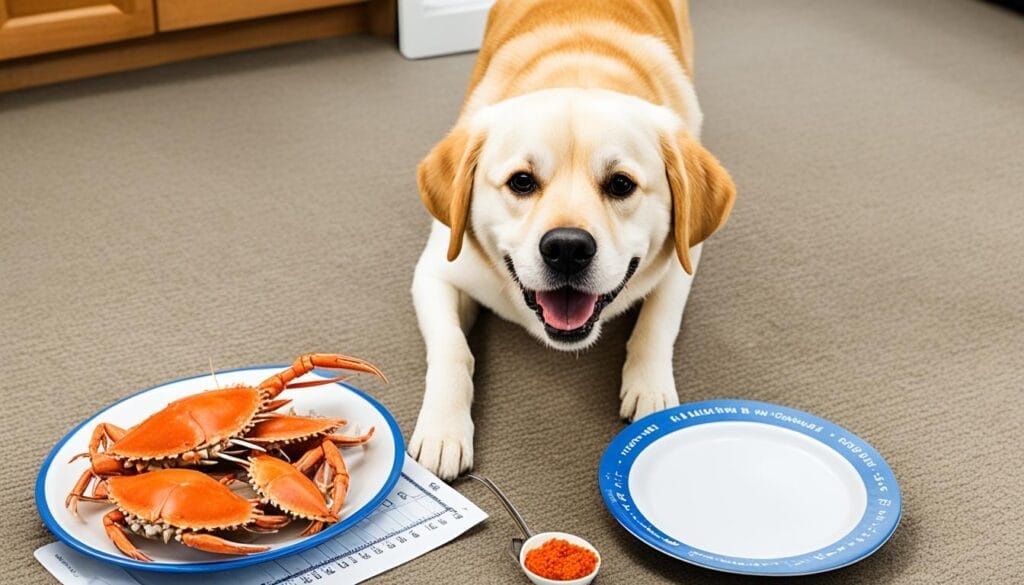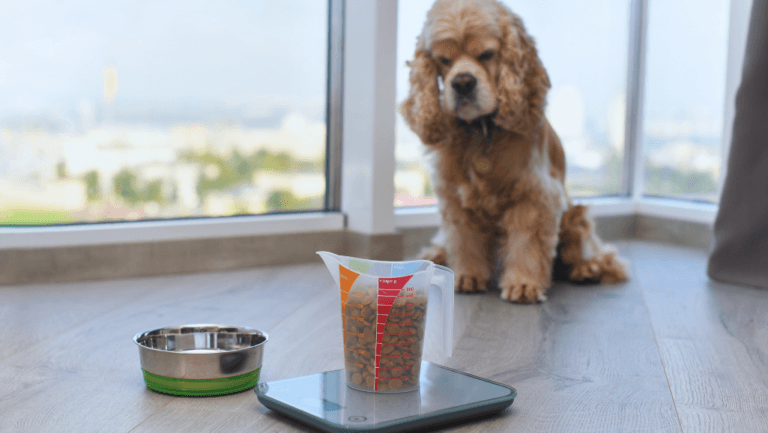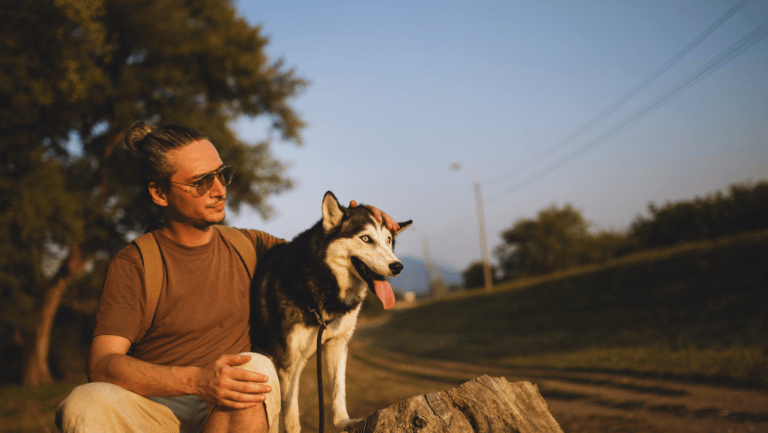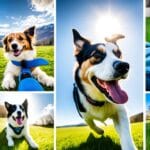Crab is a favorite seafood for many due to its taste, and it’s full of proteins, vitamins, and minerals. It’s a big part of many human diets. For dogs, it’s okay to have crab meat once in a while. But, we need to be careful and make sure it’s prepared right to keep them safe.
Crab meat has a lot of iodine and sodium, which can upset dogs if they eat too much. Give them little bits now and then. It’s super important to fully cook the crab meat to kill any harmful bugs or germs. And, make sure to serve it without any added fats or seasonings.
Always talk to a vet before letting your dog try crab or any new food. This is the best way to look after your pet’s health and happiness.
Key Takeaways
- Is Can dogs eat crab Safe for health.
- Dogs can eat crab meat in small amounts and on a limited basis.
- Crab meat is high in iodine, which may cause sensitivities in some dogs.
- Avoid raw crab due to the risk of intestinal parasites and bacterial contamination.
- Ensure crab meat is well-cooked and served plain without fats or seasonings.
- Consult your veterinarian before adding crab or any new human food to your dog’s diet.
Introduction to Dogs and Seafood
Adding seafood to your dog’s diet can be really beneficial. It contains lots of proteins, vitamins, and minerals. These are all great for your dog’s health.
But, it’s key to be careful. Dogs can’t handle too much sodium and cholesterol. These are often in seafood.
Options like shrimp, crab, and fish are great when they’re right for your dog. Take shrimp as an example. It’s low in fat and calories. So, it offers a good option for treats.
Fish is another good choice, especially in many dog foods. It’s low in fat but high in protein.
However, your dog might have an allergy. Check with a vet before adding new food. And, remember, any treats should only make up 10% of their calories.
Also, how you prepare and serve the seafood matters. Talk to a vet about it. Make sure it’s safe and in the right amounts for your dog.
In the end, introducing seafood to your dog’s diet can be great. Just do it carefully. It’s all about keeping your dog healthy and safe.
Can Dogs Eat Crab?
Many people love crab meat for its rich taste and good nutrition. Can dogs eat crab? Yes, but you must be careful. It’s important to know how to offer it to your dog safely.
Nutritional Content of Crab Meat
Crab meat is a healthy food option for dogs if served right. It’s full of good things like lean protein, essential amino acids, zinc, vitamin B12, and omega-3s. These help keep a dog healthy.
But, remember, plain crabmeat in small amounts. That’s because it’s high in sodium, cholesterol, and iodine. Too much can be bad for a dog’s health.
Benefits of Crab for Dogs
Crab meat offers a lot to dogs. It’s a healthy food choice, mainly for these reasons:
- Protein-Rich Diet: Lean protein helps maintain muscle mass and energy levels.
- Amino Acids: These are essential for various bodily functions, including tissue repair and nutrient absorption.
- Vitamins and Minerals: Zinc and Vitamin B12 support a dog’s immune system and metabolic functions, while Omega-3 fatty acids contribute to skin and coat health.
Although complete dog foods give lots of these nutrients, crab is a good extra. You should only give a little, like one tablespoon for every 10 pounds of dog, once or twice a week. This way, your dog stays healthy.
Always check with a vet before adding new food to your dog’s diet. They can make sure it’s fitting for your pet’s health needs.
Potential Risks of Feeding Crab to Dogs
Giving crab to dogs can be risky because of its high sodium and cholesterol. The shells are also dangerous as they’re hard to digest. Even though crab meat has good nutrients, it’s important to know these risks.
High Levels of Sodium and Cholesterol
Crab has lots of sodium and cholesterol. Too much can cause dogs to have health problems. Only give crab to dogs as a sometimes snack.
Possible Allergic Reactions
Dogs might get allergic to crab meat. They could start scratching a lot, get red spots, or have tummy troubles. Give them a little crab first and watch for any bad reactions. It’s also smart to talk to a vet before trying crab.
Danger of Crab Shells
Eating crab shells is very risky. They’re sharp and tough to digest. This could make a dog choke, block its stomach, or hurt its insides. Always remove the shell and cook the meat well. Then, it’s safer for dogs to eat.
| Potential Risk | Description |
|---|---|
| High Sodium & Cholesterol | Can lead to electrolyte imbalances and long-term health issues. |
| Allergic Reactions | Symptoms may include itching, hives, and digestive upset. |
| Crab Shells | Sharp nature can cause choking, intestinal blockages, and injuries. |
| Parasites in Raw Crab | Raw crab may carry parasites, posing additional health risks. |
How to Safely Prepare Crab for Dogs
Proper preparation is key for feeding crabs to dogs without health risks. Here are vital steps for safe seafood preparation for dogs:
- Cook Thoroughly: Make sure the crab is cooked all the way through. This kills any bad bacteria and parasites in raw crab.
- Remove the Shell: It’s important to take off all the crab’s shell. This prevents cuts in the mouth or throat and stops blockages.
- Keep It Plain: Don’t use any seasonings like salt, butter, or spices. These can irritate a dog’s stomach and aren’t needed.
- Cool Completely: Let the crab cool down fully after cooking. This stops any chance of burns or discomfort for your pet.
- Small Portions: Give very small pieces as a treat. For instance, give one tablespoon of plain, well-cooked crab for every 10 pounds of your dog’s weight.
By following these steps, you can keep your dog safe while feeding crabs. Always think about safe seafood preparation to lower risks. Talk to your vet before adding crab, or any new food, to your dog’s diet. This ensures it’s safe and good for your dog’s health.
Can Dogs Eat Raw Crab?
It’s not safe to feed raw crab to dogs. This is because of the risks seafood poses to dogs. Raw crab can carry parasites and harmful bacteria. This can lead to sickness and infections if dogs eat it.
Cooking crab meat well is key to making it safe for dogs. This kills off parasites and harmful bacteria. Always make sure the crab is plain and without the shell. That way, it’s a safe snack for your dog.
Crab has good stuff like amino acids, zinc, and vitamin B12. But it also has too much sodium, cholesterol, and iodine for dogs. So, it should only be a sometimes food, not a regular treat.
- Always cook crab thoroughly before feeding it to your dog.
- Remove the shell completely to avoid choking hazards.
- Serve crab meat plain, with no added seasonings or fats.
- Consult your vet before adding new foods to your dog’s diet and watch the amount they eat.
Preparing crab the right way makes it safer for dogs. This way, your dog can enjoy crab occasionally without any health worries.
Portion Sizes When Feeding Crab to Dogs
Feeding crabs to dogs means knowing how much they should get. This is really important. It helps prevent tummy problems and keeps their diet balanced. Plus, it stops them from getting too much salt, iodine, or cholesterol.
Recommended Portions by Dog Size
Dogs eat different amounts of crab based on their size. Here’s a simple rule of thumb:
- Small Dogs: One tablespoon of crab meat
- Medium Dogs: Two to three tablespoons of crab meat
- Large Dogs: Up to half a cup of crab meat
Frequency of Serving Crab
Feeding crabs should happen only sometimes. Dogs should get crab no more than twice a week. Paying attention to changes in their health and poop is very important.
For more tips on feeding dogs seafood, check out this guide on seafood for dogs.
| Dog Size | Recommended Crab Portion | Frequency |
|---|---|---|
| Small Dogs | 1 tablespoon | Twice per week |
| Medium Dogs | 2-3 tablespoons | Twice per week |
| Large Dogs | Up to 1/2 cup | Twice per week |
Can Dogs Eat Crab Cakes?
Crab cakes might look tasty to your dog, but they come with risks. They often have ingredients like garlic and onions, which are bad for dogs. The spices and high levels of sodium and cholesterol aren’t safe either.
It’s best not to give your dog store-bought crab cakes. If you want to make some at home, make sure to only use safe items for dogs. Avoid harmful seasonings. Always check with a vet to make sure it’s okay for your dog.
Crab cakes can cause allergic reactions and are very salty. Instead, if you want to share some with your dog, use plain crab meat. Make sure it’s cooked and without any shells to prevent accidents. Always watch your dog’s portions and ask a vet about new foods.
Can Dogs Eat Imitation Crab?
Many dog owners want to give their pets varied food, but they should be careful. Imitation crab, unlike real crab, is not safe for dogs. Real crab can sometimes be a treat. But the fake kind has many health risks because of what it’s made of.
What Is Imitation Crab?
Imitation crab is made from surimi, a fish paste. It’s mixed with unhealthy additives to copy real crab. These additives can be bad for a dog’s health. Even though people find it tasty and cheap, it’s not good for dogs.
Health Risks of Imitation Crab for Dogs
Imitation crab has no nutritional value for dogs. It doesn’t have the protein, vitamins, and amino acids real crab does. This can cause problems like upset stomachs and allergies in dogs.
It also has a lot of salt and preservatives. These can lead to kidney and heart problems over time. So, it’s better to avoid imitation crab. Stick to natural foods or healthy meats like chicken and lean beef for your dog.
Imitation crab might seem like a good choice to give your dog. But the risk of it causing health issues is too high. It’s best to only feed your dog real, nutritious foods. Always check with a vet before any big diet changes.
Other Dog-Friendly Seafood Options
Crab is not the only seafood that can make a good addition to your dog’s diet. Other options such as lobster, salmon, shrimp, and tuna work well too. But, make sure they’re prepared the right way.
It’s key to give your dog seafood in small portions that are fully cooked. This way, you lessen the chance of your dog getting too much sodium, cholesterol, or allergens found in some kinds of seafood. Here’s a look at different types of seafood that dogs can eat:
| Seafood Type | Benefits | Risks | Serving Guidelines |
|---|---|---|---|
| Salmon | High in Omega-3 fatty acids | Can contain parasites when raw | Cook thoroughly, remove bones, serve in moderation |
| Shrimp | Low in calories, rich in protein and antioxidants | High in cholesterol | Plain, cooked, small portions |
| Lobster | Protein-rich, contains vitamins and minerals | High sodium content | Cooked, shell-free, occasional treat |
| Tuna | Rich in protein and Omega-3 fatty acids | High mercury content | Avoid regular feeding, serve in moderation |
Before you add new kinds of seafood to your dog’s diet, check first with your vet. Also, make sure to avoid adding any seasonings or extra toppings to the fish. Adding other proteins like chicken, turkey, or beef helps keep your dog’s diet well-rounded without some of the seafood-related risks.
If you’re thinking of sharing human foods with your dog, get the green light from your vet. This is the safest way to make sure those foods meet your dog’s dietary needs.
Consulting Your Vet Before Feeding New Foods
Before you give dogs new foods like crab, it’s smart to talk to a vet consultation for dog diets. Vets know best about portion sizes, how often to give it, and if it’s safe for your pet. Crab is good since it’s full of protein, Omega-3s, and key minerals. But, it might cause allergies and has a lot of iodine.
Watch for signs that your dog doesn’t like the new food, like an upset stomach, vomiting, or itching. These could be from an allergy. Your vet can help by looking for these signs and making changes to the diet. Seafood has to be fully cooked to get rid of any parasites or bacteria. And, remember, don’t add seasonings that might hurt your pet.
So, always talk to your vet first before giving your dog any new food, including seafood. This way, your pet will get the right food that suits their health needs.
Conclusion
Feeding your dog crab means taking extra care and being safe. Crab has good things like protein and vitamins, which are great for dogs. But remember, cooking the crab well and taking out all the shells is a must. Also, watch your dog for any bad reactions they might have.
It’s best not to let dogs eat too much crab, just a little bit as a snack. Go slow if your dog is allergic to things. Always cook the crab before serving. If it’s not cooked right, it can make your dog sick because of bacteria.
Plus, watching out for small crab parts and sharp shells is important. These could hurt your dog or be easy for them to choke on. Giving your dog crab should be a rare treat, not their main food.
Commercial dog food is the best for dogs as it has everything they need. If you want to give your dog crab or any other special food, check with a vet first. This way, you keep your dog healthy and happy.
